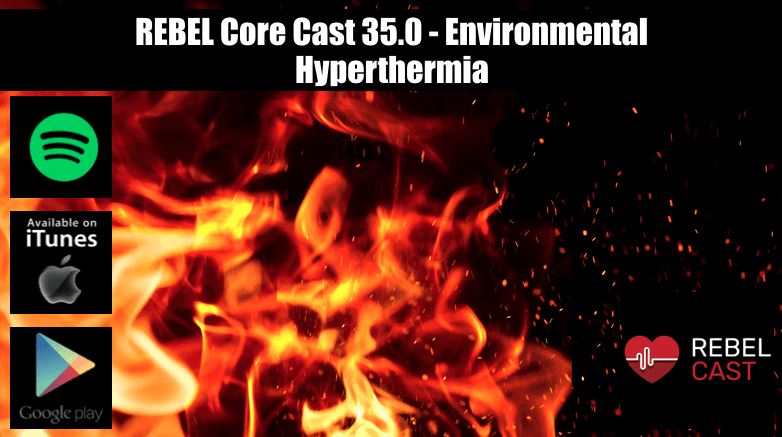
- Heat stroke is a life-threatening disorder characterized by elevated core temperature, compromise to neurologic function and multi-system organ dysfunction
- The keystone of treatment is rapid cooling within 30 minutes of presentation preferably with ice water immersion
- Patients with heat stroke should be investigated for rhabdomyolysis, AKI, liver failure and concomitant infection
REBEL Core Cast 35.0 – Environmental Hyperthermia
Heatstroke
Definition: A life-threatening emergency in which there is a failure of the body’s thermoregulatory mechanisms to handle extrinsic and intrinsic heat. The failure of thermoregulation leads to multi-system organ dysfunction characterized by alteration of neurologic function. Unlike fever, hyperthermia is not caused by endogenous pyrogens that change the thermoregulation set point in the brain. Hyperthermia results from excessive heat production and/or inadequate heat dissipation
Categories of Heat Illness
- Minor Heat Illness
- Heat Cramps: Intermittent muscle cramps likely related to salt deficiency
- Heat Edema: Swelling of the feet and ankles typically in non-acclimatized people
- Heat Syncope: Caused by peripheral vasodilation of decrease venous return
- Prickly Heat: Vesicular rash caused by obstruction of the sweat gland pores
- Heat Exhaustion
- Moderate temperature elevation (typically < 40oC)
- Caused by volume depletion secondary to heat stress
- Variant forms: water depletion, salt depletion
- Symptoms + Signs
- Nonspecific symptoms: Weakness, fatigue, headache, nausea/vomiting, muscle cramps
- Syncope
- Orthostatic hypotension
- Continued sweating
- Intact neurologic function
- Management
- Serum electrolyte measurement to help guide fluid management
- Symptomatic management
- Heat Stroke
Physiologic Changes in Heat Stroke
- Cardiovascular
- Hypodynamic states seen in elderly (or those with compromised cardiac function at baseline)
- Hyperdynamic states in young patients
- Mild volume depletion
- Edema and hemorrhage in the GI tract occur (likely due to regional ischemia)
- Acute kidney injury (AKI)
- Contributors: volume depletion, hypotension, myoglobinuria
- Coagulopathy
- Electrolyte disturbances: hypernatremia, hyperkalemia, hypophasphatemia, hypocalcemia
Clinical Manifestations
- Vital Sign Abnormalities
- Hyperthermia (typically > 41oC)
- Tachypnea
- Tachycardia
- Hypotension
- Hot, dry skin with absence of sweating
- CNS dysfunction: altered mental status, seizures, coma
Differential Diagnosis
- Sepsis
- Sympathomimetic intoxication (sweating usually present)
- Anticholinergic intoxication (sweating absent)
- Sedative-hypnotic withdrawal
- Serotonin toxicity
- Malignant hyperthermia
- Neuroleptic malignant syndrome
- Severe decompensated hyperthyroidism (i.e. thyroid storm)
Management
- Basic Interventions
- Large bore IV access X 2, supplemental oxygen (pre-oxygenation for possible RSI), cardiac monitor
- Consider early airway management for altered mental status or seizure activity
- Continuous core temperature monitoring (i.e. rectal or esophageal probe, bladder probe)
- Finger stick glucose
- There is no role for the use of antipyretics in hyperthermia management (hypothalamic thermoregulation is not affected)
- Aggressive external cooling measures
- Patients should be rapidly cooled (< 30 min) to a target temperature of 38.3oC (101oF)
- Ice bath immersion is superior to other forms of cooling (Ferris 1938, Costrini 1990, Armstrong 1996, Gaffin 2000, Vassallo 2015)
- Remove from ice bath at 38.3oC to prevent iatrogenic hypothermia
- Delays in cooling are associated with high morbidity and mortality (Dematte 1998)
- Patients should be rapidly cooled (< 30 min) to a target temperature of 38.3oC (101oF)
- Treat agitation and shivering with benzodiazepines to prevent excess heat generation
- Diagnostic Testing
- Serum labs
- Basic metabolic panel
- Common electrolyte abnormalities (hypoNa, hypoK, hypoCa, hypophosphatemia)
- Acute kidney injury
- Hepatic panel
- ALT/AST rise + peak within 48 hours
- Fulminant hepatic failure may be seen
- Cardiac biomarkers
- Troponin often elevated but may be unclear if type I (coronary occlusion) or type II ischemia
- Creatine kinase (CK)
- Muscle breakdown common in younger patients resulting from physical activity or agitation
- CK levels do not correlate with severity of rhabdomyolysis or AKI
- Urinalysis
- Can reveal rhabdomyolysis (+ blood with minimal or no RBCs on micro)
- Can reveal concomitant urinary infection
- Basic metabolic panel
- EKG
- Nonspecific ST and T wave changes are common
- Ventricular tachydysrhythmias (VF + VT) can occur
- Serum labs
- Differentiating sepsis from heat stroke can be difficult unless there is a clear exposure history (i.e. sports related). Additionally, patients can have both infection and heat stroke concomitantly. It is not unreasonable to administer broad spectrum antibiotics if there is a suspicion for an infectious process.
Disposition
- All patients with heat stroke should be admitted to a critical care unit to monitor for rebound hyperthermia, electrolyte abnormalities and multi system organ dysfunction
- Heat Exhaustion
- Young otherwise healthy patients can typically be discharged home
- Older patients with significant comorbid conditions should be considered for admission
- Be cautious in discharging patients if they are going to be at risk for recurrent hyperthermia (i.e. returning to same non-air conditioned apartment)
Take Home Points
- Heat stroke is a life-threatening disorder characterized by elevated core temperature, compromise to neurologic function and multi-system organ dysfunction
- The keystone of treatment is rapid cooling within 30 minutes of presentation preferably with ice water immersion
- Patients with heat stroke should be investigated for rhabdomyolysis, AKI, liver failure and concomitant infection
Read More:
- LITFL: Hyperthermia
- LITFL: Heat Stroke
- LITFL: Hyperthermia-Associated Toxidromes
References:
- Ferris EB et al. Heat stroke: clinical and chemical observations on 44 cases. J Clin Invest. 1938;17:249–262. PMC: 424982
- Costrini A. Emergency treatment of exertional heatstroke and comparison of whole body cooling techniques. Med Sci Sports Exerc. 1990;22:15–18. PMID: 2406541
- Armstrong LE et al. Whole-body cooling of hyperthermic runners: comparison of two field therapies. Am J Emerg Med. 1996;14:355–358. PMID: 8768154
- Gaffin SL et al. Cooling methods for heatstroke victims. Ann Intern Med. 2000;132:678. PMID: 10766695
- Vassallo SU, Delaney KA. Thermoregulatory Principles. In: Hoffman RS, Howland M, Lewin NA, Nelson LS, Goldfrank LR. eds. Goldfrank’s Toxicologic Emergencies, 10e. New York, NY: McGraw-Hill; 2015. Link Accessed September 29, 2016.
- Dematte JE et al. Near-fatal heat stroke during the 1995 heat wave in Chicago. Ann Intern Med. 1998;129:173–181. PMID: 9696724
Post Peer Reviewed By: Salim R. Rezaie, MD (Twitter: @srrezaie)
Cite this article as: Anand Swaminathan, "REBEL Core Cast 35.0 – Environmental Hyperthermia", REBEL EM blog, June 24, 2020. Available at: https://rebelem.com/rebel-core-cast-35-0-environmental-hyperthermia/.



